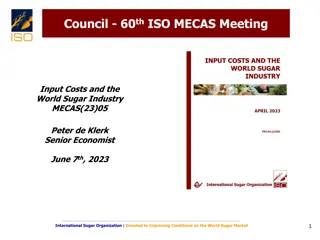Understanding Daily Materials Balance in Sugar Processing
The daily materials balance in sugar processing involves monitoring the performance of the extraction plant by tracking the tons of cane crushed and mixed juice produced. Key data needed include corrected brix and pol percentages, suspended solids, fibres, and more. Averaging methods and carrying forward figures for weekly and monthly calculations are essential for accurate analysis. Weekly to-date and monthly figures help in determining the overall performance and progress in sugar processing operations.
Download Presentation

Please find below an Image/Link to download the presentation.
The content on the website is provided AS IS for your information and personal use only. It may not be sold, licensed, or shared on other websites without obtaining consent from the author. Download presentation by click this link. If you encounter any issues during the download, it is possible that the publisher has removed the file from their server.
E N D
Presentation Transcript
NQF 5: OCCUPATIONAL CERTIFICATE: SUGAR PROCESSING CONTROLLER KNOWLEDGE COMPONENT: MODULE 3: KNOWLEDGE TOPIC 2: DAILY MATERIALS BALANCE
Background Daily Materials Balance Used to monitor the performance of the extraction plant (front-end). The tons cane crushed and the tons mixed juice per day is known because the materials are massed. The following data must be known to complete the daily materials balance. Tons corrected brix in mixed juice, which can be calculated from the brix% mixed juice (from laboratory analysis) and the tons of mixed juice. Tons corrected pol in mixed juice, which can be calculated from the pol% mixed juice (from laboratory analysis) and the tons of mixed juice.
Data needs of Materials Balance DAC Pol % cane DAC Brix % cane Suspended solids % mixed juice Obtained via laboratory results Obtained via laboratory results DAC Fibre % cane Brix % bagasse Pol % bagasse
Daily Averaging There are two ways by which averages can be calculated. The arithmetic average is the sum of the analytical results divided by the number of analyses. The weighted average takes into consideration the quantity of material associated with the analysis. Wherever possible the weighted average is used as it is a more accurate method.
Daily Figures The calculations necessary for the daily materials balance can be done once the averages are complete. The figures are carried forward daily to obtain a weekly to date figure at the end of the week or run. The process starts again for the next week or run. Figures carried forward must be weighted average figures.
Week and To-Date Figures The weekly to-date figures become the week figures at the end of the week. These figures are then combined with the previous week s figures to give the new to-date figures. Once again we want a running total of the tons of cane crushed. To find the data for any particular week we use: Week = (To-Date) (Previous To-Date)
Monthly and Annual Figures MONTHLY FIGURES These figures are produced at the end of each month. They are calculated in the same way: Month = (Month To-Date) (Previous Month To- Date) ANNUAL FIGURES These are produced at the end of each season. They are To-Date figures at that time.
Cane Payment Mill Balance This entails the determination of the brix, pol and fibre of cane from the analysis of mixed juice and final bagasse. Direct Analysis of cane (DAC) This entails the direct analysis of individual cane consignments for brix, pol and fibre. Both of these analyses depend on the analysis of fibre by the direct analysis of cane.
Formulae for Factory Control Calculations There are three types of calculations: Tons Percentages Performance formula
Tonnage calculations Water Brix Moisture Fibre Pol in mixed juice Brix in mixed juice Suspended solids in mixed juice Corrected pol in mixed juice Corrected brix in mixed juice Pol in cane (Mass balance pol) Brix in cane (Mass balance brix) DAC fibre in cane DAC brix in cane DAC pol in cane Cane per hour Fibre per hour
Percentage Calculations Fibre % bagasse Pol % cane Fibre % cane Brix % cane Fibre in bagasse % cane (uncorrected) Imbibition % fibre Corrected brix % mixed juice Corrected pol % mixed juice Purity of mixed juice Mixed juice % cane Imbibition % cane Pol % cane by material balance (Pol % cane by mass balance) Brix % material balance (Brix % by mass balance) Pol factor Brix factor Fibre factor Bagasse Purity Material balance cane purity DAC purity
Performance Formulae Extraction Corrected reduced extraction (CRE) Boiling house recovery
Daily Materials Balance See the example of a Daily Materials Balance Sheet on page 23 of the Learning Resource
Mass of Bagasse Bagasse is not routinely massed like cane and mixed juice. However the amount of bagasse produced is an important parameter and it must be quantified. The mass of bagasse is calculated by indirect method. The method is shown in the Learning Resource
The Mill Balance The Mill balance states that the mass of materials entering the extraction plant must equal the mass of materials leaving the extraction plant. Cane + Imbibition = Mixed juice + bagasse The tons imbibition water is calculated via mill balance. Most of the data on the daily material balance is calculated using the mill balance. To be able to calculate the mill balance we need to know the DAC fibre % cane so that the tons bagasse can be calculated.
The Mill Balance Cane + Imbibition = Mixed juice + bagasse
The Mill Balance Tons fibre in cane Tons Pol in Cane Tons Bx in Cane Corr. Bx 5MJ Corr. Pol 5 MJ Tons suspende d solids Tons Pol in Bagasse Pol % Cane Imb % Cane Purity MJ Tons Moist in Bagasse Tons fibre in bagasse Fibre % Cane Imb % Fibre MJ % Cane Fibre% Bagasse Tons Bx in Bagasse Ton DAC Pol in cane Bx % Cane Extraction Fibre in Bag % Cane Ton DAC Brix in cane Tons Bagasse Tons C.R.E. Imbibition
The Mill Balance An example of a worked daily materials balance is shown on Page 26 of the Learning Resource Calculations for the Day Column include: Tons fibre in cane Tons suspended solids Tons fibre in bagasse Fibre % bagasse Tons bagasse Tons imbibition water Tons Brix in bagasse Tons moisure in Bagasse Tons pol in Bagasse
The Mill Balance (cont.) Further calculations for the Day Column include: Tons pol in cane Tons brix in cane Pol % cane Fibre % cane Brix % cane Fibre in Bagasse % cane Tons DAC Brix in cane Tons DAC pol in cane Imbibition % fibre Imbibition % cane Corrected brix % mixed juice
The Mill Balance (cont.) Further calculations for the Day Column include: Corrected pol % mixed juice Purity of mixed juice Mixed juice % cane Extraction Corrected reduced extraction (C.R.E.) Further calculations include: Tons cane per hour Tons fibre per hour Calculations for the Previous column The data from the previous Week to Date column is transcribed into the columns headed Previous
The Mill Balance (cont.) Calculations for the Week to date column include: Tons crushed Tons mixed juice Tons imbibition water Tons bagasse Tons Brix in bagasse Tons moisture in bagasse Tons fibre in bagasse
The Mill Balance (cont.) Further calculations for the Week to date column include: Tons pol in bagase Fibre % bagasse Tons pol in cane Tons brix in cane Tons fibre in cane Pol % cane Fibre % cane Brix % cane
The Mill Balance (cont.) Further calculations for the Week to date column include: Fibre in bagasse % cane Tons DAC brix in cane Tons DAC pol in cane Imbibition % fibre Tons suspended solids Suspended solids % mixed juice Tons corrected brix in mixed juice Tons corrected pol in mixed juice
The Mill Balance (cont.) Further calculations for the Week to date column include: Extraction Corrected brix % mixed juice Corrected pol % mixed juice Purity of mixed juice Mixed juice % cane Corrected reduced extraction Hours available
The Mill Balance (cont.) Further calculations for the Week to date column include: Mechanical stops Operational stops Total stops Hours crushing Tons cane per hour Tons fibre per hour
The Mill Balance (cont.) DAC data The DAC pol %, brix % and fibre % cane for the day is unknown. The DAC pol %, brix % and fibre % for the previous day is unknown since it was calculated as part of the Week-to-date figures for the day before. The pol % cane, brix % cane and fibre % cane for the week-to-date must be calculated.
The Mill Balance (cont.) The DAC calculations include: DAC pol % cane Tons DAC brix in cane DAC brix % cane DAC fibre % cane
The Mill Balance (cont.) The pol % cane, brix % cane and fibre % cane via mill balance for the day has been calculated and needs only to be transcribed. The pol % cane, brix % cane and fibre 5 cane mill balance for the previous column is known since it was calculated as part of the Week-to- date figures for the day before. The pol % cane, brix % cane and fibre % cane for the Week-to-date must be calculated.
The Mill Balance (cont.) The Material Balance / Mill Balance calculations include: Pol % cane Brix % cane Fibre % cane
The Mill Balance (cont.) Calculations of factors for the Day , Previous and Week to date columns include: Pol factor Brix factor Fibre factor























